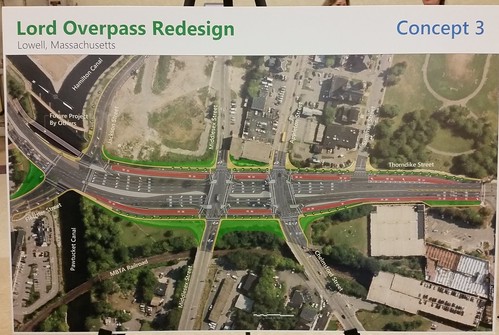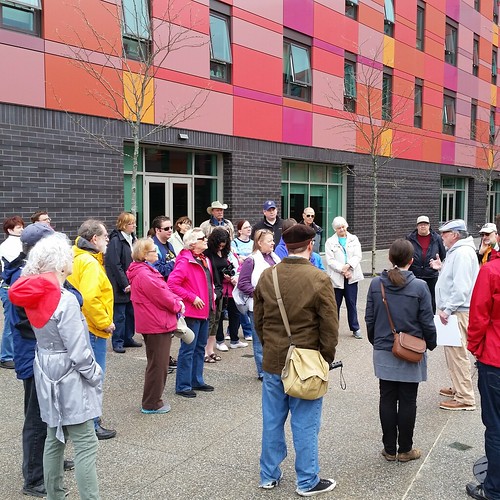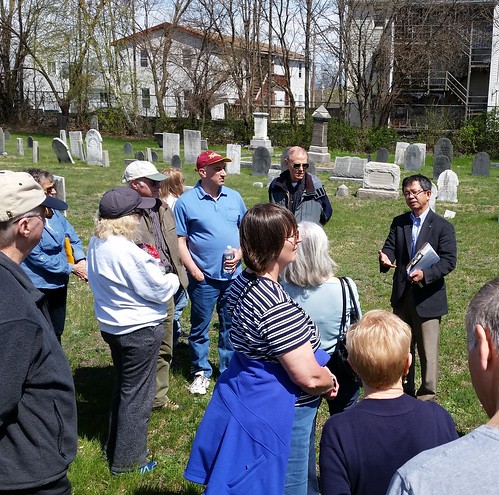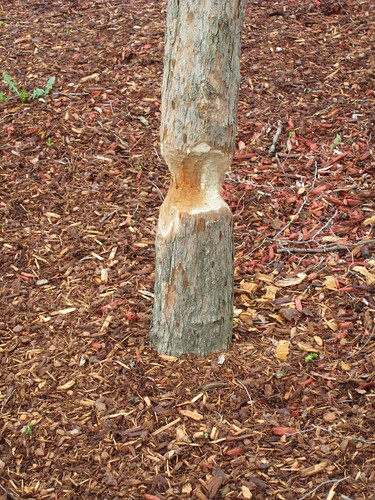Lowell Week in Review: April 24, 2016
A family trip took me to Washington, DC last Sunday so I did not post a Week in Review. Since I returned, I’ve played catch up on the news but it doesn’t seem like I missed too much locally. Still, there are a few items deserving of mention:

Proposed design for “new” Lord Overpass
Jeff Speck on Lord Overpass: Go Back to the Drawing Board
Internationally-known urban planning guru and one-time Lowell resident Jeff Speck stumbled upon the plans for the redesign of the Lord Overpass from afar and wrote a thoughtful blog post on the topic.
Speck is not impressed. Oh, he likes the proposal’s idea of filling in the Overpass and raising Thorndike Street to the same grade as Appleton and Middlesex, but his fondness for the project ends there. He zooms in on the intended street layout and sees swooping curves and too-wide lanes that will encourage cars to drive too fast. He sees ‘treeless concrete wedges, medians, and ‘pork chops’ designed to move traffic quickly” rather than pedestrians safely and enjoyably. He also condemns planners for wasting space on either side – the plan now calls for green space on either side – because Speck believes that buildings with businesses open to the public that touch the sidewalks and provide vertical definition are critical to a successful streetscape.
In perhaps his strongest indictment of the Lord Overpass plan, Speck presents an overhead photograph of the entrance to the parking lot of the Mall of America in Minnesota and shows how much the proposed Lord Overpass street layout resembles it.
Speck urges Lowell planners to look to the classic boulevard as a model for the remade overpass. He even provides a sketch of how it should look – at no charge – and offers the following as both a critique of the Lord Overpass plan and as suggestions for its improvement:
- Walkable streets do not have swoops, slip lanes, pork chops, and other features that encourage drivers to make fast turns;
- Walkable streets have narrow lanes, typically 10 feet wide—even for buses;
- Walkable streets place continuous shade trees in any medians;
- Walkable streets have parallel parking along every curb, to protect pedestrians (and potentially bikes) from moving traffic; and
- Walkable streets are lined by buildings that give them life, and in urban locations these buildings are tall and sit directly against the sidewalk.
“All of the above criteria, in addition to making pedestrians feel welcome, contribute to an environment in which cars drive more safely. Students of urban form will recognize that they all come from studying the proper model, the classic boulevard.”
Having heard Speck speak when he was last in Lowell, I know he has great affection for the city and what it has accomplished. His “tough love” approach here is meant to improve a concept that he readily acknowledges is a step in the right direction. I believe his blog post is a call to action for all of us, for as Speck says, “It is not too late for Lowell to embrace a model that will transform this site from a place that is easy to get through to a place worth arriving at.”
City Council Activity
Like me, the council went on vacation last week, at least on Tuesday night. There was a meeting the previous Tuesday, April 12, which I haven’t yet discussed (although I posted meeting notes that same evening). Here are the highlights of that April 12 meeting:
City Manager Murphy introduced the team from Skanska USA which will serve as the “clerk of the works” of the new Lowell High School project. Other than the introductions and some background about Skanska’s experience in school construction (extensive), not much of substance regarding the process – like a construction time line or possible sites – was discussed.
Another interesting discussion arose from a seemingly innocuous request for travel funding. Unlike the typical request that sends a city employee to a conference or training somewhere, this one was to pay for airfare and hotel costs for City Councilor John Leahy to attend Congresswoman Niki Tsongas’s 3rd District Day (for which Leahy was leaving the next day, I believe). An awkward silence was broken by Councilor Rita Mercier who questioned the propriety of the city paying for what she said “sounded like a junket.” Rodney Elliott was mildly critical of the request, pointing out that when he and Councilor Mercier travelled to Cambodia two years ago, they paid their own way. Elliott’s main point, though, was that nothing had been budgeted for something like this and this kind of ad hoc expenditure was not good fiscal policy. Mayor Kennedy and Councilor Samaras both spoke of the potential benefits to the city of such trips but seemed to concur that the council should establish a policy and some funding for future events like this. A motion to that effect passed as did Leahy’s travel request, but not before Councilor Mercier demanded that he report back to the council at a future meeting on the benefits to the city that came from this trip. [We anxiously await that report].
There was also a council-initiated discussion on panhandling with councilors again expressing frustration about the continued complaints about panhandlers. As one of the commenters to my council meeting blog post observed, this is a complicated issue that needs “a multi-faceted strategy involving coordinated assistance and mitigation.” As a starting point for this discussion, everyone should just accept as a given that one person has the right to ask another person for money. The Constitution as interpreted by the courts leaves no wriggle room on that issue, and efforts to get legislatively cute will just lead to more losing litigation and legal costs. Consistency is a good starting point when it comes to new ordinances: A city councilor who, as a candidate, will stand on a street corner with a campaign sign, waving at cars going by, but who as a councilor votes for a law that would ban someone else from holding a sign that asks for money while standing in the same spot and waving at the same cars, probably shouldn’t be on the council in the first place.
Perhaps the best approach for the city to take is to copy its response to the opioid epidemic which is to throw everything imaginable at the problem: education, treatment, counseling, and enforcement of existing laws. Plus lots of meeting and lots of publicity. I’m not sure anything the city has done has made a dent in the opioid epidemic – the statistics don’t show that happening – but at least everyone feels like we’re DOING SOMETHING about it. With panhandling, it almost seems that the biggest problem is the feeling of impotency that the council has on the issue. More meetings, more discussions, more education, more forums, statistics on littering fines and jaywalking tickets, all of that stuff. It would make everyone at least feel that something was being done and, who knows, it might even help some of the panhandlers in a meaningful way.

Bob Forrant talking about Urban Renewal in Lowell
Lowell Walks 2016 Kickoff
The rain cleared just before the 10am start time of yesterday’s Urban Renewal walk. Forty people joined UMass Lowell History Professor Bob Forrant on a walk through the Northern Canal Urban Renewal Project, now known as the UMass Lowell East Campus. The walk began at the University Suites dormitory at the corner of Aiken and Perkins Street with Bob displaying some poster-sized photographs of bulldozers plowing through the wood frame houses of Little Canada. From there, we walked up Pawtucket Street past Fox Hall to the Northern Canal, then down the north bank of the canal, past the Wannalancit Mills complex to the Jeanne d’Arc Credit Union headquarters. We ended up on the west lawn of the Tsongas Center, overlooking the Merrimack River. Urban Renewal was a federal program of the 1960s that paid cities to demolish “slums” (also known as people’s homes) that is probably more controversial today than it was when implemented. Whatever one’s opinions on the program might be, everyone can agree that Urban Renewal played an enormous role in shaping Lowell for at least a half century. If you want to learn more about the program and how it affected Lowell and other Merrimack Valley cities, Bob and his friends at the Lawrence History Center are holding an all-day symposium on the topic on Saturday, May 7, 2016. Check out the event’s website for more information.

Vesna Nuon talking about Cambodians in Lowell at School St Cemetery
The Urban Renewal walk was not our only stroll through Lowell history yesterday. At 1:30, I was joined by Vesna Nuon in leading a Cambodiatown Walking tour that began at Clemente Park. This walk was organized by Lowell National Park as part of the Cambodian New Year celebration that took place at the park throughout the day. Twenty-four people joined this walk which talked about the history of the park (100 years ago it was the site of the most modern baseball stadium in America); then visited the School Street Cemetery; the site of the July 2014 fatal Branch Street fire; and the 1877 Branch Street fire station (the city’s busiest). Across the street from that was the place where Lowell Police Officer Chris Rouses was shot and killed while responding to an armed robbery at Limby’s Drug Store on November 17, 1987 (Officer Rouses and three other officers killed in the line of duty in earlier years are memorialized by the Christos G. Rouses Memorial, the sculpture of a police officer and a young boy located on JFK Plaza). The walked ended a Pailin Plaza, a vibrant neighborhood retail complex.
For 2016, Lowell Walks has plenty of downtown tours but has also branched out to the neighborhoods. To see the full schedule, check out the “Upcoming Events” section in the left column of this website (click “view all events” to see all the walks). To get weekly updates, add your email address in the “Sign Up for Lowell Walks Newsletter” box in the right column.
Below: You never know what you will encounter on a Lowell Walk.

Beaver damage to a tree on the West Lawn of Tsongas Center
Dick, thank you for this report. I agree fully about Jeff Speck’s analysis of the Lord Overpass. Slips are difficult for pedestrians to navigate. Think about the parking garage on Market Street. The original Market Street project was meant to remove the traffic slips into the garage. But as I understand it there was some uproar about preserving the tree in front of the garage which meant keeping the slip. These slips are similar to my personal pet-peeve, the right hand turn arrow, especially where the city is trying to encourage pedestrians, i.e. Pawtucket and School Streets. This, in my opinion, makes drivers to become more anxious about getting through the light and forces pedestrians to stare down drivers into allowing them what should be the pedestrian’s by right. And city councilors wonder why so many people jay walk?
There also should be parking along Thorndike at the Lord Overpass. This will encourage development of the land straddling the overpass. It also has a tendency to slow cars down. I am still not sure why we should be obsessed with moving cars quickly through Lowell. Should we be enabling people to get to NH or to Dracut? As I understand it, most of the Lord Overpass is going up Fletcher which quickly becomes one lane each way. As I see it, there will be a two minute savings by keeping the overpass auto-centric while keeping pedestrians as an afterthought. More pedestrians will bring more development whereas more cars brings more residents to Dracut and New Hampshire and more congestion in Lowell. I encourage everyone to send in comments to the city about the overpass. We need to make this area pedestrian friendly. Ten foot lanes are plenty wide enough for cars, buses and trucks. This will also free up more space for adequate parking, bike and pedestrian amenities. It may also free up more space for development.
Following Speck’s plan to add street parking is the best thing that could happen to Sal’s Thorndike St mill project. Lots of short term metered parking will be good for the two restaurants he plans on opening. The property value and tax revenue collected from the old mill will go up with Speck’s plan. New parcels being created by Speck’s plan that can defray costs is genius.
People are going to tie themselves in knots trying to say Speck’s plan is not good while not trying to screw Sal Lupoli at the same time.
It’s like arguing that biking is bad when every person on a bike is one less person in a car, contributing to congestion. Except Sal isn’t some nameless loser on a bike.
WBUR is currently presenting reports on transportation issues, mostly inside route 128, but I find them quite informative. The following is a link to WBUR’s main site: https://www.wbur.org. The articles are listed under their BOSTONOMIX section. The following site contains some of their poll results: https://www.wbur.org/2016/04/26/mcgee-ride-along-mass-traffic. One result that I find discouraging is that 34% of those polled would like to see highways widened in order to improve traffic problems.
Transportation is real problem in eastern Massachusetts and we need to find solutions that work locally and regionally to encourage alternatives to cars. I despair that there are no real regional alternatives other than the car. We should be thinking about making public transportation interconnecting with other gateway cities like Lawrence, Haverhill, and Worcester as well as places like Burlington, Woburn, Waltham, Somerville, Cambridge and Boston. One example is the Green line extension has no provision to meet up with the Lowell Line in Medford. This makes many places like Tufts much harder to reach.
It’s hard to come up with a reason to oppose the Speck plan. As Paul Early says, we don’t gain anything by helping through traffic.
When I first moved to ATHM, I walked downtown on Dutton, which was just dreadful. Fortunately, cutting through the parking lots lets me avoid Dutton. I would be delighted to walk on a tree-lined Dutton, either to downtown or to the rail station.
If we think of extending downtown along Dutton and Thorndike, and through the Hamilton Canal development, the Lord Overpass plan — reimagined as the Speck plan — becomes completely obvious.